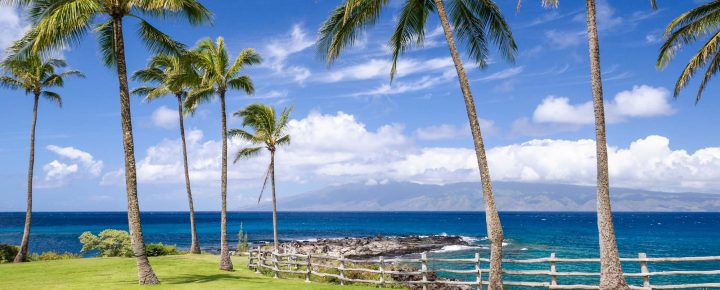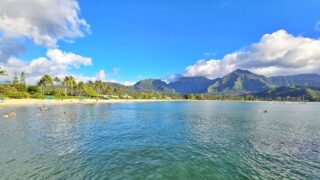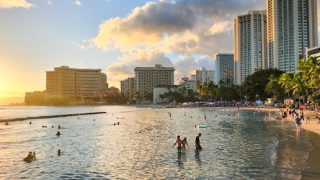As Copenhagen rolls out enticing perks for sustainable tourists, the question arises: could Hawaii adopt similar strategies to balance its own tourism and environmental goals? Recent developments and community feedback in Hawaii suggest that the Aloha State is at a crossroads with the potential to still lead in the arena of sustainable tourism.
Copenhagen is enhancing its reputation with easily accessible, actionable and genuinely sustainable initiatives that is focused on visitors, and is something easy for them to achieve. Hawaii’s HTA, on the other hand, has launched “Qurator,” which instead certifies businesses like Hawaiian Airlines that are deemed eco-friendly. Thus far, that seems to have largely missed the mark.
Qurator has been met with skepticism. Critics argue that this program might be more about marketing than actual sustainable practices, as detailed in our recent article. The certification includes businesses such as airlines that may not align with true sustainability, raising concerns about both its authenticity and effectiveness.
Beat of Hawaii editors plan to visit Copenhagen, as we seek to investigate other global initiatives that can help Hawaii move forward in tourism .
Copenhagen’s green tourism model.
Copenhagen’s innovative “CopenPay” initiative offers a range of free perks to tourists who engage in desirable sustainable practices, such as using public transport, biking, or participating in environmental cleanups. This trial program, which runs from July 15 to August 11, 2024, but is expected to evolve thereafter, allows visitors to earn rewards like free meals, coffee, kayak rentals, museum admissions and more by proving their eco-friendly actions. The program emphasizes trust and ease of participation, with no need for apps or formal registrations, aiming to inspire tourists to adopt sustainable habits effortlessly while exploring Copenhagen.
This unusual, comprehensive approach incentivizes green behavior while leveraging something that Hawaii currently falls short on, a robust infrastructure for sustainability, making it a leading example of how destinations can encourage responsible tourism in more positive ways.
This model encourages visitors to make environmentally friendly choices, reducing the city’s carbon footprint while enhancing its reputation as a green destination, and making it all enjoyable and inviting to its tourists.
Contrast Hawaii’s current tourism landscape and Qurator program.
Hawaii’s tourism industry is starting to undergo significant changes, with a renewed focus on sustainability. The Hawaii Tourism Authority (HTA) recently received a $60 million boost to support sustainable tourism and manage visitor impacts. This funding aims to revitalize Hawaii’s tourism sector, but its effectiveness depends on addressing past management issues and aligning with genuine sustainability goals. It also isn’t focused directly on visitors, but rather on specific businesses it recognizes for their sustainability.
Key articles:
- New Hawaii Tourism “Certification” | Greenwashing Or Genuine? questions the authenticity of the HTA’s sustainability new Qurator certifications.
- Will Hawaii’s New Tourism Move Elevate Your Vacation or Twist It Beyond Recognition? highlights the mixed reactions to HTA’s funding and its controversial leader, Mufi Hannemann.
- Plan Cutting Maui Vacation Rentals Aligns With Global Tourism Shift explores the implications of reducing vacation rentals on sustainability.
Potential initiatives for Hawaii.
Drawing inspiration from Copenhagen, Hawaii might seek to extend its own sustainable tourism strategies:
Eco-friendly accommodation incentives:
- Provide discounts or perks for Hawaii visitors who stay at eco-certified hotels.
- Offer tax incentives for hotels adopting a range of desired sustainable practices.
Promote public transportation and biking:
- While public transportation and biking are not entirely feasible throughout the islands, efforts can be concentrated on areas with high tourist density and available services. Free or discounted bus passes could be introduced where infrastructure supports it, although there are limitations. For example, Oahu’s The Bus system would need significant expansion to accommodate a high visitor demand.
- Could a further expanded Kauai Path include biking opportunities from Lihue north that might get people out of their cars and help reduce the Kapaa crawl.
Develop and encourage eco-tourism programs:
- Lead in helping create packages and offers that include activities like hiking, snorkeling, and cultural tours focused on environmental education.
- Partner with local businesses to offer discounts on desirable eco-friendly activities, services and programs.
- Launch dynamic, engaging campaigns to entice tourists in preserving Hawaii’s natural beauty and cultural heritage.
Your comments and concerns.
Recent comments on Beat of Hawaii reflect a mix of optimism and skepticism on future initiatives:
- “The HTA’s new funding is a step in the right direction, but we need more transparency and genuine action, not just greenwashing.“
- “Promoting eco-tourism is great, but what about the locals? We need to ensure these changes benefit the community, not just tourists.”
- “Incentives for sustainable travel are good, but they need to be substantial enough to make a real difference.
- “While the idea of sustainable tourism is appealing, I just can’t trust the Hawaii Tourism Authority (HTA) to implement it effectively. Their track record on managing funds and genuine sustainability efforts is questionable. HTA’s recent initiatives seem more like greenwashing than actual sustainability. How can we be sure this won’t be another marketing gimmick?“
- “I don’t want to be told how to travel or forced into specific behaviors. While sustainability is important, people should have the freedom to choose how they engage with it. Programs like this can feel too restrictive. Visitors might appreciate guidelines and incentives, but mandates in Hawaii could be a turn-off.“
Challenges and considerations for Hawaii.
Implementing these initiatives in Hawaii presents several challenges, including infrastructure development, funding, and community buy-in. The HTA’s ability to balance economic benefits with environmental protection will be critical and their performance remains in question. Past controversies, such as those highlighted in Hawaii Tourism Overhaul, underscore the need for clear, effective management in order to produce tangible results.
Copenhagen’s success with sustainable tourism may offer good modelling for Hawaii. By adopting similar strategies, Hawaii can hopefully enhance its reputation as a leader in sustainable tourism, while making it easily accessible by visitors. The HTA, under new leadership, has an opportunity to demonstrate real commitment to sustainable practices that also meet visitors’ needs
We welcome your comments on the future of Hawaii tourism.
Get Breaking Hawaii Travel News







It seems as though Hawaii subscribes to the same “rainbows and unicorns” theory as our one party system does in calunicornia. It. Doesn’t. Work. Vote. Them. All. Out.
Offering incentives for desirable behavior sounds like a good idea. Maybe include some free beach days for beaches that charge visitor fees, or make it easier to reserve at locations that require reservations. It would be good to consider what desirable behaviors, beyond staying at eco-friendly hotels, would be rewarded.
I’m sorry but when the apple has a worm dangling from it, I don’t eat the apple. This whole thing is just sand being thrown in the air by the corrupt politicians to blind people so they ignore the rotten apple and the worm. Until they are fired, nothing they do will benefit the people or the only source of revenue left in Hawaii (tourism). At least this proposal indicates that they are desperate and know their time is up so they are throwing spaghetti against the wall hoping it will stick. Starting with the governor, fire them all.
Aloha editors,
As a 17 year blessed and privileged resident to live on Kauai I have one major point. Take care of the inhabitants first.
If I’m not mistaken Denmark is supposed to be one of the happiest places on earth and I don’t mean a Disney attraction. I firmly believe if your locals are happy, 25% of Kauaians are considered food insecure and housing forces young families to leave and raise their children elsewhere, then the visitors will be happy. This is why spending millions on improving an airport in Honolulu that is not that great is maddening. We need to get our priorities straight.
I actually will be in Copenhagen in a few hours and had read about their initiatives. It will be interesting to see if anything is noticeable that tourists might be doing or how the plan is advertised in the city.
Hi Kathy.’
Look forward to hearing back from you on that. Thanks.
Aloha.
Well, over 10 miles of walking around the city I saw nothing about the initiative. There were bits of trash here and there and never saw anyone pick up anything. I did watch a man in a wheelchair drink three cans of Coke in a doorway (while we waited out rain) and just drop them on the ground before he wheeled away.
There are no short term solutions to Hawaii’s problems.
Five years from now Hawaii will have the same problems.
Comparing Hawaii to Copenhagen is laughable. Let’s get a few diesel busses running around 80% empty so that tourists can hop on and off an earn a green badge. How about deciding if you want tourism or not. And then how many. Bring back the sugar and pineapples or develop new local commercial enterprises so that tourism and taxation aren’t the only businesses. The on again off again hostility towards visitors is getting tiresome. We’ve been coming to Maui for over a dozen years, and now constantly have second thoughts.
We are now debating ever going back. Love the people and the place but the political crap and expense of it all is getting out of hand.
I think there is an underlying approach that Copenhagen is taking that would work for Hawaii. Basically, Copenhagen is looking for “carrots” to motivate people to act in ways that they want. Hawaii seems to be looking for “sticks” which are aligned with the interests of hotels and politicians. This has nothing to do with diesel busses – this is about a mindset and how to motivate people.
Copenhagen’s program is clearly aimed at the 100 million or so Youth in Europe who can hop on a train, spend a few days at a cheap hostel party like crazy and trade a few hours of labor for a sandwich. In other words, Europe for $50/day.
Applicability of this concept or, more on point, this target cohort of potential visitors to HI?? Is there a probability less than Zero?
C’mon folks, Face reality. Hawaii is a Completely Unique (for too many obvious reasons to list) tourism market. There aren’t now and won’t be any “solutions” to copycat from anywhere, because nowhere else is anything like Hawaii.
Oh brother. What a bunch of buzz words. A grab for federal money. Hawaii officials should visit a tourist spot on the mainland and then replicate 1st world concepts such as sidewalks, clean toilets, and parking.
I would venture to guess that if the government were removed from the equation, private enterprise, I.e. capitalism, would figure out how to make this work in a way in which people and private enterprise would work. The system would need oversight, because they’d only be motivated by dollars, but sensible, logistical and convenience-based services would be derived. Again, oversight would be needed (think e-scooters, like the fiasco that happened in San Diego), but an equilibrium would be reached which most would find agreeable. That being said, no amount of rationale or sensibility will appeal to those who don’t want tourism, nor will it appeal to those whose livelihood is derived from feeding at the government fiscal trough. One would have figured out by now that no amount of government interference would fundamentally change market dynamics any more than it would change a person’s gender. Oh well.
Anything involving Mufi Hannemann is immediately suspect. The HTA blows a lot of smoke, but remains firmly mired in shady backroom deals and ineffective policies. No real change will come until Hannemann, his cronies, and acolytes are purged.
Regarding the Kapaa crawl…
“Could a further expanded Kauai Path include biking opportunities from Lihue north that might get people out of their cars and help reduce the Kapaa crawl” I don’t think the tourists are going to be using the bike trail for getting around. And aren’t the residents just commuting during those crowded crawl times?
Patrick:
Your are correct on the residents commuting part. No one is going to hop on a bike, in any event, that highway is way too dangerous. Extending the paved beach path may induce some walkers-joggers-bikers for a a bit of fun/exercise, but no one is suddenly not going to rent a car because the beach path is extended. That is called magical thinking.
Exactly! Extending the bike path in either direction won’t do one thing to lessen the Kapaa traffic or take one car off the road.
Who needs HTA advertising Hawaii? We already have too many tourists. The problem is intra-island transportation-the Kapaa by-pass should have been completed years ago along with a workable intersection with the highway. Do they really think tourists are going to ride bikes with luggage to the North Shore–in the rain, at night? Does the Kauai bus even go to the airport–it didn’t, and then drivers would not allow luggage on the bus. Taxis and shuttles are more expensive than renting a car for a day and Uber is unreliable especially from the North Shore-make a reservation and it gets cancelled the day before! It appears some entity is forcing and benefiting from car rentals! The businesses that profit from tourists need to support local transportation. 1 Hotel seems to have figured that out and they are New to the Island. There have been some attempts at local bus service on the North Shore but funding, staffing and unreliability ended it.
I took the Kauai bus to/from airport-Hanalei multiple times some 10-12 years ago. We live out in Haena-Wainiha, so required hitching a ride or a nice neighbor to get into Hanalei (and that stretch of road is dangerous for bikes, although some do it). Then a first bus (was $2 at the time) to Walmart, then either walk/hitch ride to airport (I did that serval times) or take a short route bus from Walmart (used to be 50 cents). The entire adventure was at least 2.5 hours IF you timed the bus perfectly in Hanalei. And I did not have a large suitcase. Most Kauai bus drivers did not allow large suitcases, although plenty of people brough all kinds of things (e.g., shopping bags) on board.
Hawaii is missing 2 things that make a Copenhagen approach unrealistic:
350 million people who can drive to it or take a short ferry.
2nd, there’s realistically one political party – incest at its worse. Not much political give and take.
Hawaii needs look at itself on a map and chart it’s own course, consistent with tb US Constitution.
When living in upcountry Makawao for six years, we found biking on the island was super limited to a short trail in Waliea and another short trail near the airport (protect your ears)! Public transportation was quite difficult for even locals. We certainly understand the need to incorporate conservation consciousness in caring for the island, regular beach cleanups and developing respect for the flora and fauna, yet I think the mark is being missed by thinking that public transportation and encouraging bicycling will create the environmental improvements being aimed for.
Thousands of scientists and professionals over decades state the so-called “green”, or net-zero, or climate crisis is a hoax. I can provide many references. Carbon dioxide (CO2) is not pollution. CO2 is a trace gas necessary for all life on earth. The amount of human CO2 added to air is tiny and not measurable against the background of natural fluxes of CO2 emitted and absorbed by nature. Hawaii’s “green” law version of sustainability if implemented means economic disaster for Hawaiians. This law is especially dangerous for islands dependent on tourism and locally grown/raised food. Hawai’i’s mistaken law must be repealed.
“More CO2 is good for the world, it’s not bad for the world. And so, it’s absurd to be trying to reduce CO2,” Prof of Physics at Princeton U., William Happer, Sky News Australia last year. “If you look at the geological history … we’re in a CO2 famine now compared to what’s normal for plants.”
Copenhagen has industry to support this kind of investment. Hawaii has no other source of income (except the military ) than tourism and it’s already too expensive. Hawaii is essentially broke. So where’s the money going to come from? $60 million is nothing. Let’s see a 20 – 30 year plan that includes all the financials. I bet Copenhagen has one. Ask for it when you visit.
Hey for $300k you can get a study going.
Comparing what is happening in a city in Denmark to a State in the USA is just laughable! If that concept actually has to be explained to you then you are already a lost cause. Hawaii’s problems have been generated from within and the same individuals, think of somebody with the name “Mufi”, are the ones now charged with fixing the problems and you have exactly what is wrong in Hawaii today! It is truly amazing just how much the good old boy network is still flourishing in Hawaii and yet the voters do nothing about it other than whining about it. Choices have consequences so maybe the next election cycle you all start thinking about making different choices!
The Copenhagen model seems all carrots and no sticks, whereas everything I seem to read about HI is about discouraging anyone but rich tourists, then milking them with fees for any tourist behaviors (like $30 beach parking fees irrespective of time spent, 18% accommodation taxes and talk of $50 arrival fees) on top of very hefty lodging costs. Lots of sticks, where’s the carrots?
The carrot is a coupon for half-price sandwich if you rent a bike